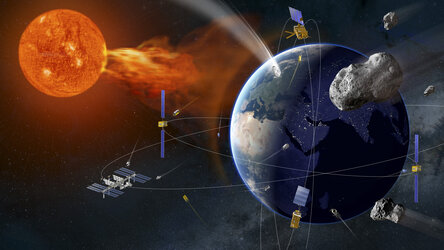Refreshing the Neutral Buoyancy Facility
Summer is over and maintenance of the Neutral Buoyancy Facility has begun at ESA’s Astronaut Centre in Cologne, Germany. However, at 10 m deep and containing 3.7 million litres of water, refurbishing this training ground for spacewalkers is no ordinary task.
ESA’s Neutral Buoyancy Facility (NBF) was built by the German Aerospace Centre DLR in 1990 and was last refurbished in 2007 in preparation for the 2009 astronaut selection and their initial spacewalk training at EAC. The water tank has also been used to test ESA prototypes for lunar tools.
Nine months in the making
Refurbishing the NBF water tank takes nine months. Work began in August, when training mock-ups and diving equipment were covered to protect them from the dust expected to be generated by the repair. Emptying the tank took seven days and provided a rare occasion to replace all the old water that had been circulating in the closed loop filtration system for over a decade.
Once the refurbishment is complete, 3.7 million litres of water will be pumped back in over three weeks and reheated to 28°C for long underwater dives and training sessions. Diving activities are expected to resume in spring 2021.
Boosting ESA astronauts' spacewalk capabilities

Extra Vehicular Activities (known as EVAs or spacewalks) are the most challenging tasks for an astronaut. When venturing from their spacecraft in a self-contained spacesuit to carry out repairs or install new equipment outside the International Space Station safety and efficiency are vital.
Since spacewalks cannot be practised under real conditions on Earth, other elements that bring astronauts closest to weightlessness are used and neutral buoyancy is substituted for microgravity.
ESA astronauts wear NASA’s extravehicular mobility unit (EMU) suit during spacewalks from the International Space Station. Though this suit isn’t available at EAC, trainers have developed unique pre-familiarisation and proficiency training that prepares astronauts for spacewalk training at NASA’s Johnson Space Center in Houston, Texas, USA.

Through this training in the NBF, astronauts learn basic EVA concepts and skills such as tethering to the Station, how to use special EVA tools, how to communicate with an EVA crewmate and with the control room, and how to retain full situational awareness in a complex and challenging environment.
“Thanks to a fruitful cooperation with NASA over the last 16 years, ESA has bridged the skill gap between an astronaut with solid SCUBA diving experience and the training requirements inside a real spacesuit at NASA” explains ESA spacewalk instructor and Head of the EVA Training at EAC Hervé Stevenin.
“This innovative training has been implemented in the NBF for the ESA astronauts selected in 2009 and boosted their EVA skills to a point, that a majority of them were assigned to very challenging and successful EVAs during their missions.”
ESA’s spacewalk training programme has been continuously enhanced through the last decade and also allows refresher EVA training sessions in Europe for ESA astronauts between their EVA-suited training campaigns in Houston.
The underwater Moonwalk

ESA’s NBF water tank has also proven valuable in preparing for future exploration activities such as in the low gravity environment on the Moon.
“The underwater environment can not only mimic weightlessness, but it can also offer a great simulation of lunar surface gravity through a smart finetuning of a slightly negative buoyancy,” Hervé adds.
“With the French company COMEX supporting ESA for diving operations in the NBF, we have carried out successful underwater EVA lunar tests in simulated lunar gravity. In 2021 we will also use the NBF to test the new prototype of LESA (Lunar Equipment Support Assembly /Lunar Evacuation System Assembly), an innovative lunar tool caddy with the capability to help rescue an astronaut on the Moon surface.”
After its refurbishment, the NBF will be fully operational for the next 10-15 years to train the current and next generation of astronauts for spacewalking from the Space Station. It will also play an important role in further testing lunar surface operations and preparing astronauts, as ESA goes forward to the Moon.















 Germany
Germany
 Austria
Austria
 Belgium
Belgium
 Denmark
Denmark
 Spain
Spain
 Estonia
Estonia
 Finland
Finland
 France
France
 Greece
Greece
 Hungary
Hungary
 Ireland
Ireland
 Italy
Italy
 Luxembourg
Luxembourg
 Norway
Norway
 The Netherlands
The Netherlands
 Poland
Poland
 Portugal
Portugal
 Czechia
Czechia
 Romania
Romania
 United Kingdom
United Kingdom
 Slovenia
Slovenia
 Sweden
Sweden
 Switzerland
Switzerland







































